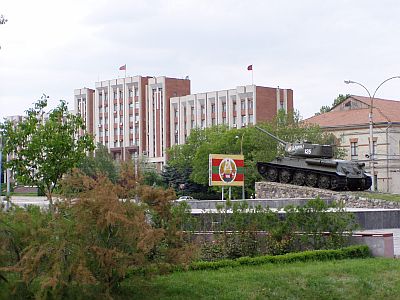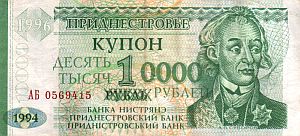History - a short overview
The PMR republic was founded in the year 1990, making it the youngest republic in the territory of former Soviet Union. Nevertheless the PMR is not recognized by any other 'official' country. The conflict between Moldova and Transnistria is much older. Moldova united with →Romania in the year 1918, whereas the area east of the Dniestr remained under Russian resp. Soviet control. The small strip of land was named Moldavian Autonomous Socialist Soviet Republic (MASSR) and belonged to the Ukrainian Socialist Soviet Republic. Already at that time, Slavic minorities outnumbered the Moldovan population - in contradiction to the area west of the Dniestr, historically known as Bessarabia.
After the 'liberation' of Moldova by the Red Army in 1940 (to be followed by the Nazi German occupation from 1941 to 1944), Bessarabia was united with Transdniestr to form the new Moldovan Socialist Soviet Republic (MSSR). As in any other Soviet republic, a massive 'Russification' campaign was launched. This included the introduction of the Cyrillic script. Needless to say that this time was harder for Moldovans than for Russians. The real problems started in 1989. The Supreme Soviet of the MSSR decided to substitute the Cyrillic script for the original original Roman (Romanian to be exactly) script. Historically spoken, this was a logical consequence for Bessarabia, but not for Transnistria (also: Transdniestr). Thus, Transnistrians, ie mainly Russians and Ukrainians, were afraid of discrimination and demanded for a referendum. The fact that the government in →Chişinău could not convince the Slavic minorities that there won't be a unification with →Romania strengthened the minorities' resolve to fight for independence.

| ||
| Tiraspol: Supreme Soviet and War Memorial |
In 1990, numerous polls took place in Transdniestr. Around 96% of the voters (with a turnout of 79%) decided for the partition of the country. Not only the inhabitants of the area east of the Dniestr but also the citizens of →Bendery were polled. The Supreme Soviet of Moldova declared the poll void, whereupon Transdniestran representatives left the Soviet. Soon they declared the foundation of the Transdniestran-Moldovan Soviet Socialist Republic (TDMSSR) as an autonoumous republic as a part of the USSR. Later, the 'Soviet-Socialist' was erased. Thus, the name became TDMR. It should be mentioned that not all Transdniestran representatives voted for independence. Of course, the Supreme Soviet of Moldova ignored the decision. The TDMR made the biggest town on it's territory, →Tiraspol, its capital and started to build up selffence forces. Additionally, the 14th Russian Army, based in and around Tiraspol, was about to play a decisive factor in the forthcoming conflict.
The first incident took place in November 1990. Protesting women occupied administration buildings in Dubăsari. The protesters were removed violently and three people shot. Within the same month, another poll took place. Now, 98% of the voters acknowledged the foundation of the TDMR. The breakaway republic continued establishing its own police forces and army. Gradually, the Moldovan executive was driven out the country - partially with the use of force. The situation escalated in 1992 when the smouldering conflict developed into a full-scale war. In March, Moldova imposed martial law on the entire country. Many of the weapons used in the conflict came from the 14th Russian army, which was accused of supporting the TDMR. Fights broke out in →Bendery on the west bank of the Dniestr. The Moldovan police were attacked and called Chisinau for help. Moldovan troops took the city on the 20 June 1992, but paramilitary forces remained in parts of the city. After several attacks and heavy street fights, Transdniestran forces managed to recapture the town on 26 June. One reason for the success of the Transdniestrans was probably the fact, that the Moldovan forces, although employing heavy artillery and jet fighters, hadn't manage to destroy the one and only bridge over the Dniestr in the area. Sporadic fights broke out in Dubăsari as well. There's no reliable figure regarding the victims, but an estimated 500 to 1,000 people were killed during the short war.
After calling a truce, the 14th army remained in the country (Transdniestr only) in order to provide stability. However, in 2004 we got the impression that the army has left - all the large barracks we've seen in Tiraspol were empty or used by Transdniestran forces. Still, some Russian peacekeeping forces remain in the country (see →picture). In 1995, Transdniestr passed its own constitution. According to the PMR constitution, freedom of speech and religion are guaranteed. The president is elected every five years (practically, Igor Smirnov is the president since 1991 without interruption). The president is also the head of the Soviet. There are wild speculations over Transdniestr, partially spread by Moldova and the Western press. Rumours say that Transdniestr is a mafia infested place full of corruption, human trafficking, road banditry and that Transdnistran scientists would have supported the Iraq and provided military aid for South Ossetia and so on and so forth. Things like these are hard to (dis)prove, since the PMR is internationally not recognized and therefore there's a lack of monitoring. However, it's widely accepted that nepotism seems to be a serious problem. Internationally not recognized is only half truth. The sovereignty of Transdniestr is recognized by other non-recognized countries only such as Abkhazia (a secessionist republic in →Georgia) or Nagorny Karabakh (an Armenian exclave in Azerbaijan, occupied by →Armenia.

| ||
| The galloping inflation in the 1990ies produced weird banknotes |
Although the country is heavily industrialized, the economic situation is very bad and the country is just dirt poor. According to various sources, the average monthly wage is € 30 only. After a decade or so of runaway inflation, the financial stability seemed to have stabilized. Poverty is omnipresent - even in the capital next to the presidential palace. Some enterprises appear to be quite successful - among them a steel mill, the company Sheriff (a printing company!?), which is recently erecting a brand new stadium for the local soccer team and Kvint - a well-known cognac producer (throughout the CIS) and others. The export volume of industrial products of Transdniestr is higher than the export volume of the Republic of Moldova. Transdniestr declares that it has signed export contracts with around 50 different countries.
The future is absolutely unclear. Recent surveys show that almost all citizens of Transdniestr are not willing to return to Moldova. Why should they? The economic situation in Moldova is not much better. Fortunately, neither Moldova nor Transdniestr have the financial resources to start another bloody war. But will Transdniestr ever be recognized by other countries? The leaders of the PMR are still in hopes of a revival of the Soviet Union. I've seen new passports from PMR citizens with CCCP (Cyrillic for USSR) written on them. Maybe Transdniestr should form a union with →Belarus - it would be some sort of a communist dream team.
©2024 Europe-East.com

 Albania
Albania (Transnistria)
(Transnistria)